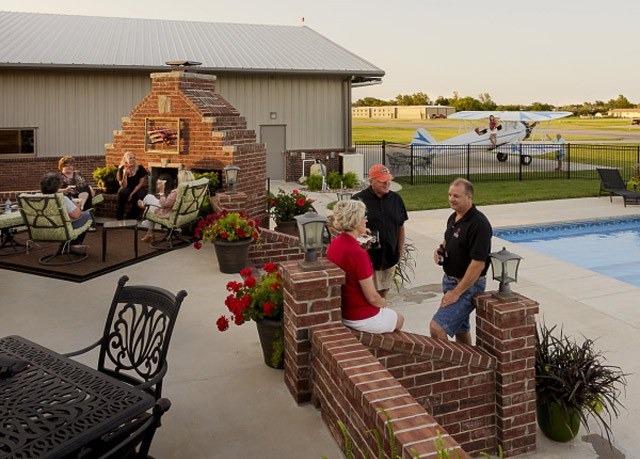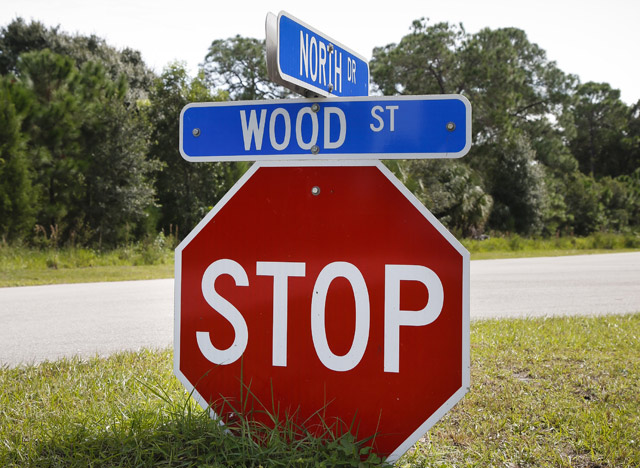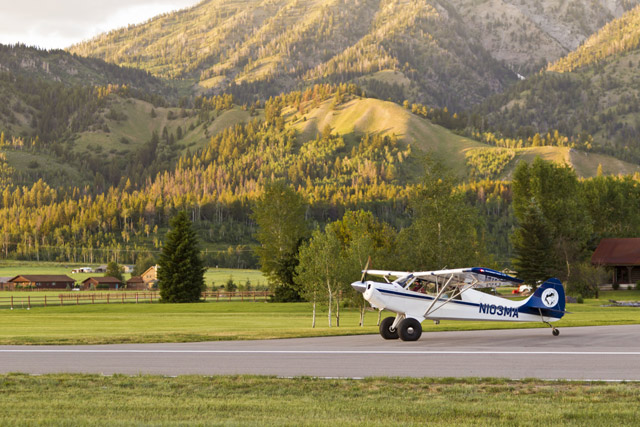Living with the love of your life
Residential airparks let pilots cozy up to their true loves: their aircraft
Ask someone who lives in an airpark how long they have been there and more often than not, you’ll hear 10 years, 15 years, or even 30. Airparks—residential subdivisions where people can keep their airplanes colocated with their homes—sound too good to be true to passionate aviation buffs. Thanks to a few visionary land-use planners, aviators, and realtors, however, they have been reality for nearly 70 years.
Where are they? They exist in 48 out of the 50 United States, in Canada, Mexico, South Africa, Europe, and Asia. Take a U.S. terminal area chart—OK, pull up any Class B airspace in your flight planning software—and zoom in. Scan the area 15, 20, 30, and 40 miles out from the center. See all those small private airfields? If you are on your computer, browse over to the residential airpark directory online. A quick correlation will show you that many of those little magenta airfields are airpark communities.
Some, such as Kentmorr Airpark on Kent Island, Maryland, or Palmetto Air Plantation in Manning, South Carolina, are small and intimate groups of just a few homes around a pristine grass strip. Others—such as Daytona Beach, Florida’s Spruce Creek; Asheville, North Carolina’s Mountain Air; and Palm Beach’s Wellington Airpark—are urban multi-use affairs, with paved, lighted runways sporting instrument approaches and literally hundreds of homes spread over acres of property. If you are more of a wide-open-spaces gal or guy, there are airpark communities in Texas, Utah, Idaho, and Wyoming that offer a bit of spread—10 to 25 acres per parcel. It’s all out there.
It’s a lifestyle
Airparks are not normal neighborhoods. Ask an airpark resident why he lives there and watch the goofy smile spread slowly across his face. Watch them puff up a little bit, the same way they do when they are talking about their aircraft, their flying. Some can explain the feeling, calling it kismet, calling it perfection—some cannot. That’s how it is with love.
“Living in a fly-in community is cohesive,” says Carol Vandervliet, a resident of Florida’s Buckingham Airpark for more than 15 years. “We love that aviation seems to be the central thread that binds our neighborhood together, despite our diverse backgrounds and cultures. Aviation is an equalizer.”
Buckingham is a through-the-fence (TTF) airpark, meaning the community does not own the airfield affiliated with it. “In our case the runway is owned by Lee County Mosquito Control, and we have negotiated the right to access and use it,” she said. A new federal rule governing TTF airpark operations went into full effect last October; however, Vandervliet’s airpark is exempt (see “Through-the-Fence Rules Change,” this page).
Still, it pays to be good neighbors. “We voluntarily repair the runway each year, and invite the guys from mosquito control to all our community events, even our association meetings. We have first right of refusal to purchase the airport if mosquito control ever opted to sell it,” she said.
The reasons for buying into an airpark community are many. For Tom Woodward it was the desire for country living crossed with an easy commute to work in the Dallas-Fort Worth metroplex. “I’d lived on a farm with an airstrip, so I knew how good that could be,” he said. Pecan Plantation, a grand 2,200-acre multiuse development with two runways, golf courses, tennis courts, RV camping facilities, grocery store, and fitness center along Lake Granbury, some 20 miles southwest of Fort Worth, Texas, fit the bill.
“The whole thing grew up around a cropduster strip, but it is so much more than that now, with hundreds of homes, many high-end,” he said. “We have neighbors who aren’t fliers—with all the other amenities, that is natural—but our properties have deeded rights to the runways,” he said. “That was important to me.”
The builders
The airpark concept seems to have no definable beginning, developing organically across the country. Bill and Lillian Morris just wanted a vacation spot they could fly to easily from Washington, D.C. In 1945 they bought the land that became Kentmorr Airpark, on the eastern shore of the Chesapeake Bay. Morris plowed up a potato patch to create a grass runway, and built a bungalow for his family atop his airplane hangar—perhaps one of the first hangar-homes in the nation.
Today 14 homes surround that pristine 2,000-foot-long patch of turf. Residents are avid aviation enthusiasts, and include workers from the Smithsonian’s Paul E. Garber restoration facility and docents at the Smithsonian’s Steven F. Udvar-Hazy Center at Dulles International Airport.
Twenty years after Morris founded Kentmorr, Frank Smith—an inventor, cattle breeder, and entrepreneur—plotted out Hidden River Airpark on land along the Myakka River near Sarasota, Florida. That bucolic spot is home to a paved, lighted runway; guest parking; and more than 90 homesites on lots as large as 10 acres.
About the same time, across the country in Salem, Oregon, newly minted architect Glenn Plymate was working with his state board of aeronautics on a new airport just outside the capital, in Independence, Oregon. “I think I got the job because my thesis had been designing a general aviation airport,” says Plymate with a smile, remembering. “They were all pilots, the board members, and they were truly progressive,” he said. “We were able to get federal and state funds, and we were careful to plan the runway so that it could be paved and expanded when the need arose.” During the land acquisition phase of the airport’s development, space was left between the airport and the road system for an imaginative developer, according to Plymate.
In the mid-1960s he moved on to airport management positions that took him south, to California. It was more than 20 years before he returned to discover that, during his absence, the public airport he’d designed and built had developed a beautiful symbiotic relationship with a purpose-built residential community of pilots and aviation enthusiasts on its doorstep. “It was the most incredible airpark I’d ever seen,” he says. “There were dedicated taxiways for airplanes and dedicated roads for cars. When you drive in from the land side you can’t tell it is an airpark. It looks just like a subdivision anywhere,” he says.
In the past 20 years he’s watched the airpark grow from 40 to nearly 200 families. A dedicated aviation community, the neighborhood benefits from the aviation businesses on the public side of the fence, which include a restaurant and FBO with maintenance facilities and fuel for sale. The TTF operation has been impacted by the new legislation, but not radically. Homeowners pay a modest fee of about $180 per year for the right to use the public airport.
My story
Like Vandervliet, Woodward, and Plymate, I’m an airpark veteran and I’ve got no exit strategy. I see no need.
I call my Florida neighborhood of Pine Shadows an aviator’s nirvana. For an airport “junkie” such as I am, waking to the rising pitch of a Continental engine being pushed to full throttle means the day is starting out perfect. It’s as pleasant as bird songs in the morning, and serves to remind me that I’ve got the option to fly my own little airplane, a Kitfox IV, at my whim (and the weather’s). It’s right there, not 20 yards from my bedroom window, safe in the 60-foot by 60-foot hangar we built for it in front of the house.
Day trips for work are a cinch. Roll out of bed before sunrise, cued by the coffee machine burbling in the kitchen. I can be airborne shortly, watching that beautiful ball of fire ooze above the horizon, setting the high cirrus aflame with bright pink and purple morning light. Best of all, when the job is done, the trip home puts me back on my own doorstep—most of the time before supper.
Our 36-year-old community near Fort Myers, Florida, is homes with hangars, and some homes with architecturally integrated hangars, all on 70-odd one- to three-acre lots, ringed around two lakes. Because of the preference for lakefront living our autos share the taxiways with the aircraft, but aircraft have the right of way. It is not a perfect system (we have had an airplane-auto encounter); yet with proper care on the part of pilots and drivers, it works fine.
We each own a share of the paved, lighted runway; the fuel farm; the taxiway/roads; the gate. As a group we fund it all through homeowner association dues and the occasional assessment. Also, as a group we defend the clearways for takeoff and landing from encroachment by development (FAA rules protecting public airports don’t apply to our privately owned airport), which happens from time to time. Sometimes it is a cellphone tower, other times it is a request from an adjacent landowner for building height variances. It helps that our runway is bordered on two sides by a county preserve.
Caveat emptor
Deciding on an airpark to live is so much more than just deciding if you want to fly off of pavement or turf. Before you succumb to my siren’s song, please, take the time to research any airpark you are considering. These properties are unique commodities, with valuations to match.
Navigate to Ben Sclair’s excellent website (http://livingwithyourplane.com) and gather as much information as you can about your prospective development. Find out how old the development is; how many homes already exist; who the homeowner association president, or in lieu of that, who the developer is. Obtain and review a copy of the most current covenants, conditions, and regulations (CC&Rs).
Set up a visit and try to fly in (make sure you get a briefing on the airport’s procedures), so that you can assess the area from both land and air. Compare the CC&Rs against what you see in the park. Are the rules being enforced? Do they even make sense? Visit more than once, during different seasons, and attend a homeowner’s association meeting or a community barbecue so you can feel out the personality, vitality, and viability of the place.
While you are conversing with your potential new neighbors, make sure you find out how well the airpark’s essential services work. Is there city or well water? Sewer or individual septic systems? Digital cable or satellite-only broadband entertainment and communication options? What are the local taxes? Association dues, fees, and assessments? How does air traffic control in the area function? If you are contemplating bare property, make sure to find out if there are architectural guidelines or size restrictions. Ask all the questions, right down to which cellphone services work best inside the gates.
Finally, wander outside of the airpark gates and get a bead on how close critical infrastructure lies, from hospitals to highways, schools, recreational areas, places of worship, and grocery stores. There is life outside the airpark to consider, too.
Is your heart set? Take the next step and search out a realtor who understands fly-in communities. That realtor can help you find financing, too. Airparks are not always well-understood by the banking industry, and properties must be properly represented to them (sometimes even creatively) in order to cement a deal. Property insurance is another challenge for fly-in aficionados. Agents can get confused when you explain that you keep your airplane in the “garage.”
Deciding to live with the love of your life, be it your spouse or your aircraft, is a commitment worth making—so, once you are smitten, carry through with grace. We look forward to welcoming you to the community.
Amy Laboda is the former editor of Women In Aviation International magazine and is currently working as a freelance writer—living the dream.
Through-the-fence rules change
The FAA Modernization and Reform Act of 2012, signed into law on February 14, 2012, took full effect October 1, 2014. Section 136 of this law permits general aviation airport sponsors, as defined in the statute, to enter into residential through-the-fence (TTF) agreements with property owners or associations representing property owners.
According to FAA records, there currently are as many as 130 different TTF agreements between airports and property owners in the United States, most of them involving airpark fly-in communities. (That’s more than 20 percent of airparks nationwide.)
The new law codifies in exquisite detail what the parties to these agreements can and cannot do. Specifically, they prohibit commercial activity and fuel sales on the airpark side of the fence. That means your resident airpark mechanic won’t be doing annuals in his hangar by his house. He’ll need to move into a commercial space on the airport for that.
Same goes for that independent flight instructor doing preflight briefings around his kitchen table and using his home-hangared airplane to charge for instruction.
Most critically impacted could be TTF communities at airports that provide commercial air service. While the law is explicit in its permission for publicly owned general aviation airports to enter into residential through-the-fence agreements, it is silent with regard to commercial service airports and privately owned reliever airports. The FAA has interpreted this silence to continue the prohibition on the establishment of new residential through-the-fence agreements at these airports.
More information can be found online.











